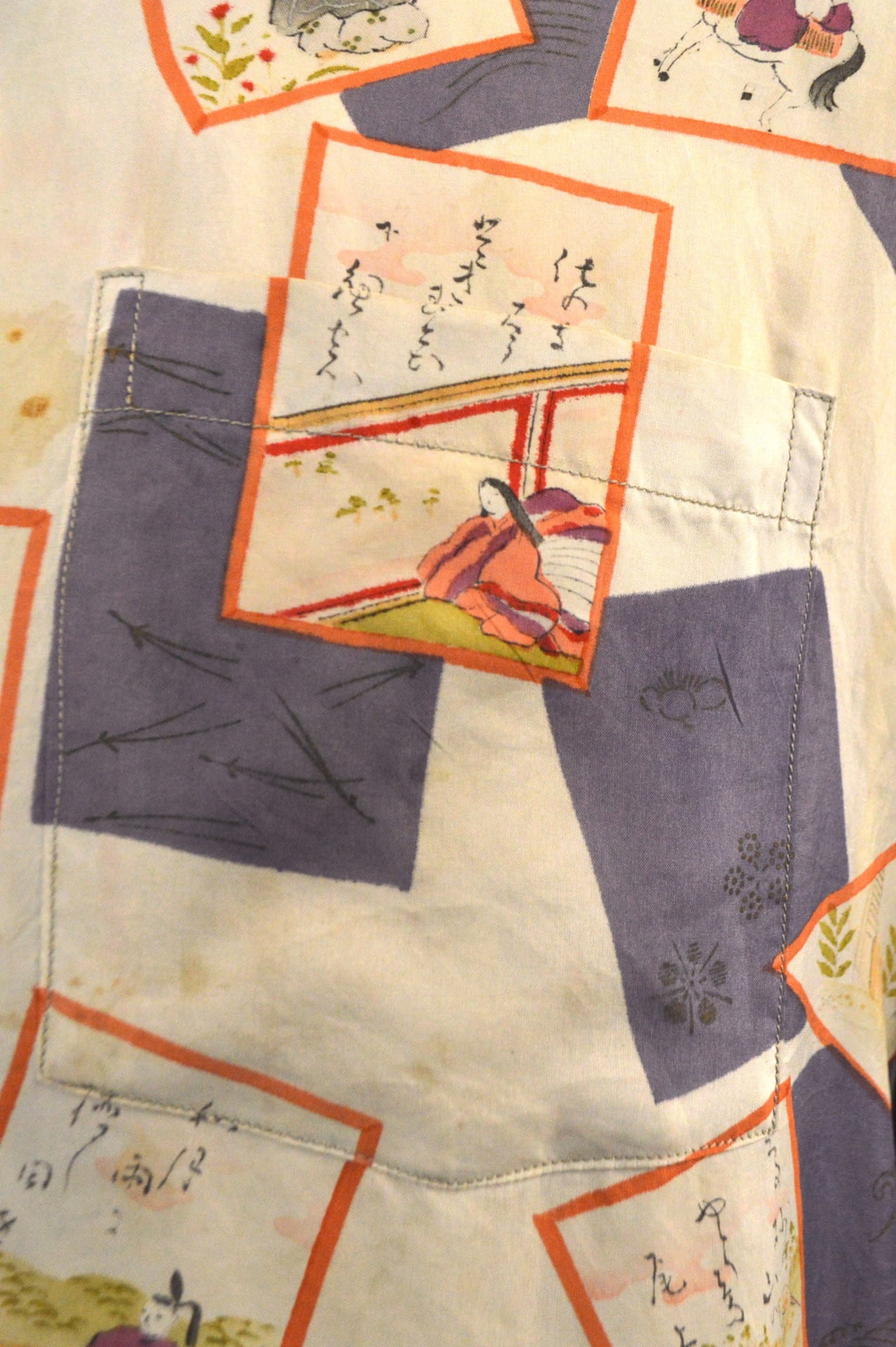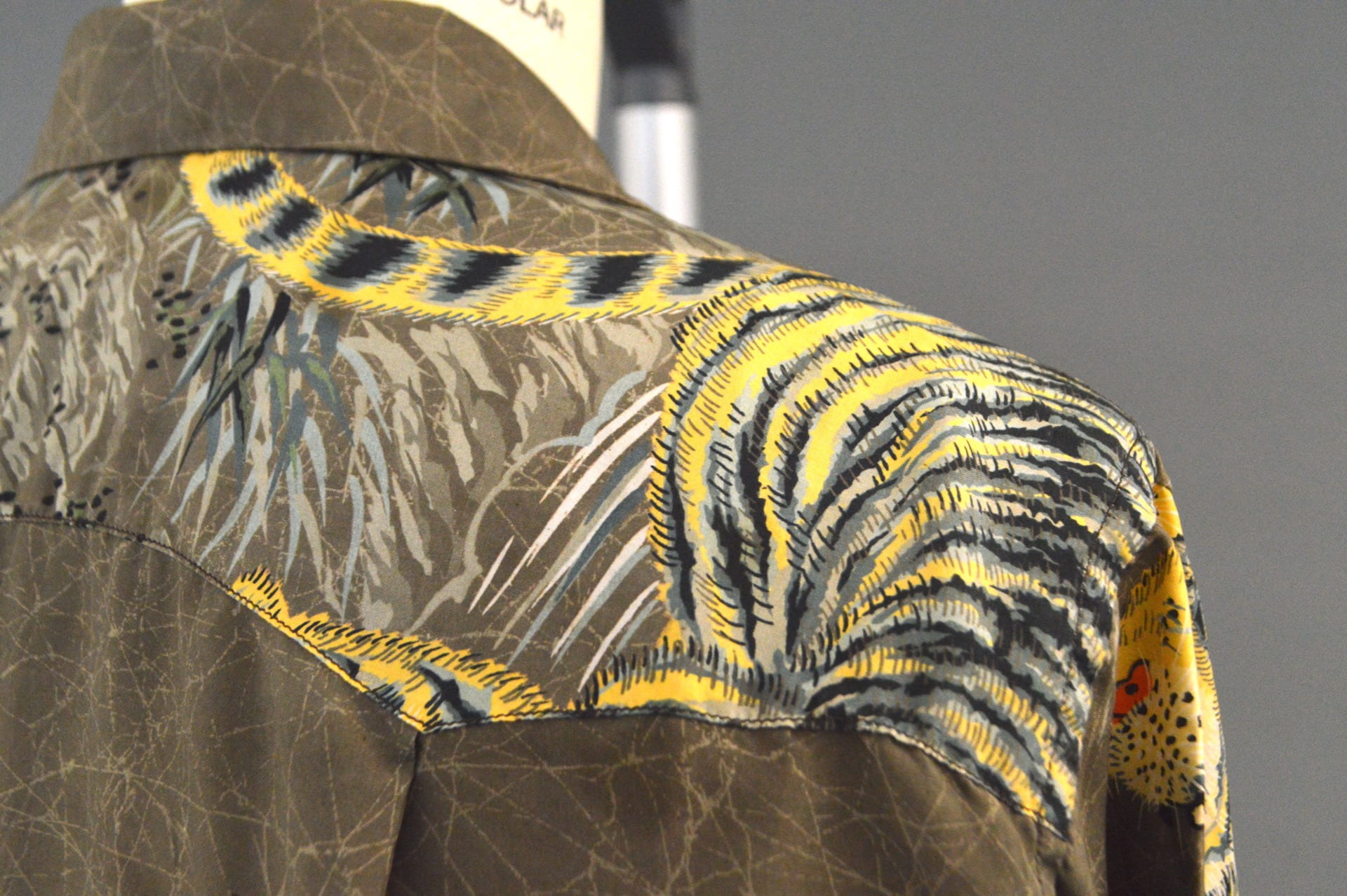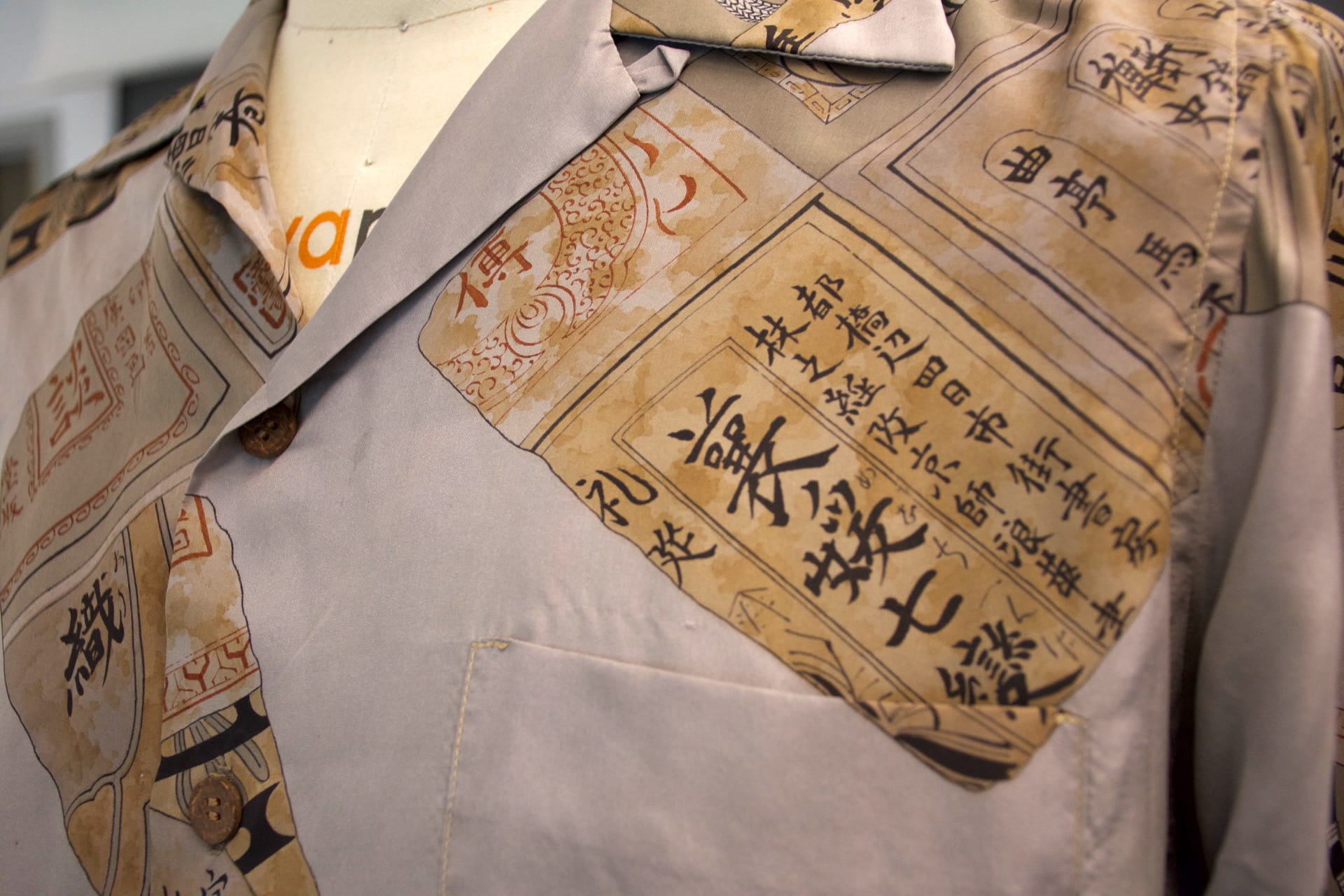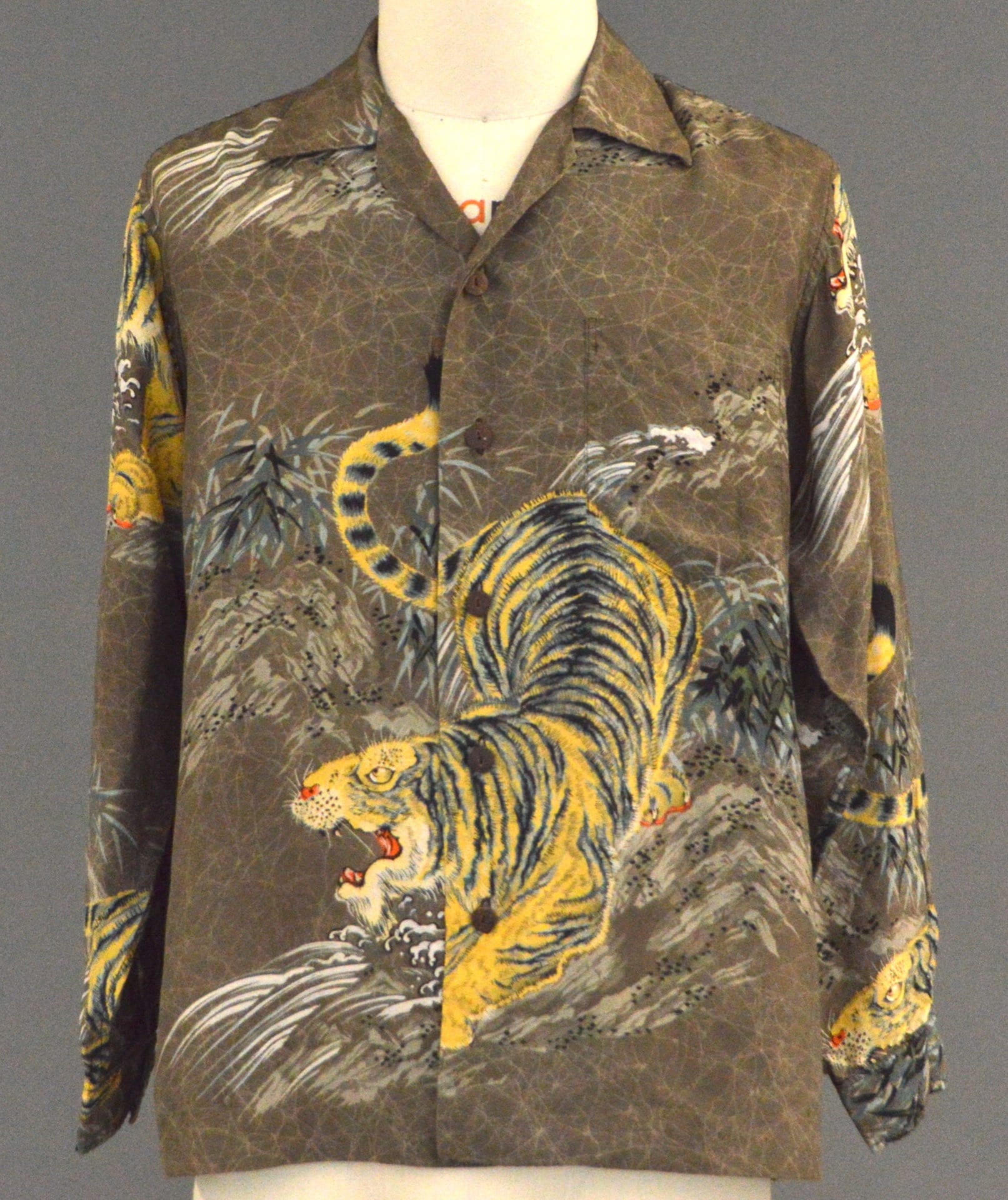Blog post by Georgia Hausmann ’21.
It is not uncommon to see a plethora of viscose or cotton-polyester Aloha or Hawaiian-style shirts on the way to the beach, or when walking into the resort section of a clothing store. In fact, I would say it’s a common sight. I once loved digging through boxes of these shirts at second-hand thrift shops; however, it was not until recently that I discovered the deep and complex history that contributed to this pop culture fashion movement.
Hawaiʻi has a unique and rich history, and the Aloha shirt is a material expression of a part of that ongoing history. The garment tells a story about cultural exchange, immigration, and imperialism. The Aloha shirt is said to have originated in the 1930s, reflecting the interaction of many immigrant groups. By 1936, the term “Aloha Shirt” was trademarked by Ellery Chun, who supposedly invented the shirt in 1931 (“Ellery Chun,” 2000). Around this same time, Hawaiian pidgin, a creole language, was on the rise and unified people of many ethnicities in the Hawaiian Islands. The language and the garment both acted as an integrating force between people of many backgrounds.
Aloha shirts differ from other forms of ethnic dress in the way that they promote inclusivity in the multiethnic culture of Hawaiʻi . With the arrival of Westerners in the late 18th and 19th centuries came infectious diseases and the tragic loss of thousands of Native Hawaiian lives. From the 1850s into the early 20th century, Chinese, Portuguese, Japanese, Korean, and Filipino peoples immigrated to Hawaii. According to fashion studies scholar Linda Arthur (2006), “no one ethnic group is in the majority,” and by the time Hawaii became a US state in 1959, about 10% of the population on the islands of Hawaiʻi were ethnically Hawaiian (p. 10). The Chicago School of Sociology, for example, has used Hawaiʻi as an example of ethnic harmony. The Aloha spirit is a public code in Hawaiʻi , “which maintains that interaction between individuals should occur without reference to ethnic prejudice” (Arthur, pg. 13). The Aloha shirt represents ethnic unity of Hawaiʻi , a deep and profound meaning that is more than just a “costume” or party theme. People tend to purchase and wear the classic Aloha shirt while in and outside of Hawaiʻi , but the responsibility of the wearer to know what the garment represents seems to only vaguely exist.

Pocket detail of a 1950s Aloha shirt donated by Jay Gould Schurman to the Cornell Costume & Textile Collection. Accession #2005.01.26
The Aloha Shirt stems from the palaka shirt, a shirt that was mass-produced for Portuguese and Hawaiian plantation laborers in 1922 (Arthur, 2006). The palaka was modeled after the collared button up that was brought to Hawaii by the American businessman; however, it was short-sleeved and had a checkered print (“Ellery Chun,” 2000). Within a decade, printed cottons with Asian motifs on Japanese silks and yukata cloth fabrics were readily available. “Chinese, Japanese, and Euro-American tailors were busy in the Islands,” according to Arthur, readily transforming Japanese silk kimono fabrics or cotton broadcloth into Aloha shirts (Arthur, pg. 15). These early designs referenced Chinese and Japanese motifs due to the development of industrial roller printing in Asia in the 1930s: at this time, 56% of aloha shirts featured Japanese or Chinese motifs (Arthur, pg. 17). Other designs at the time included Western and Polynesian motifs, while only 23% of the shirts promoted the “colorful, romantic tourist destination” we commonly see today, in large part thanks to the efforts of the Hawaiʻi Tourist Bureau (Arthur, 2000, pg. 17). Design motifs dramatically transformed over time. After the surprise attack on Pearl Harbor by the Imperial Japanese Air Service, “Japanese motifs on Aloha shirts fell out of favor and reduced significantly to 18% […] and Hawaiian motifs more than doubled” (Arthur, pg. 20). By the 1990s, 57% of Aloha Shirts represented Hawaiian and tourism-inspired design motifs.

Motifs on a 1940s silk Aloha shirt in the Cornell Costume & Textile Collection. Donated by Jay Gould Schurman.
Locals began adopting the Aloha shirt during the second world war due to the halt of shipping between the United States and Hawaiʻi . Residents of Hawaiʻi could no longer access western garments and thus embraced Aloha wear as a result. Even after shipping was no longer curtailed, the Aloha shirt only gained popularity with locals and tourists alike. After the war, a more durable rayon was introduced that held dyes and had a smoother finish; this practically replaced the original silk Aloha shirt because it was less expensive to produce and had a similar feel and weight (Wentzel, 1989). As time progressed, the popular Aloha shirt became almost exclusively made of rayon, cotton, or blends of cotton with other synthetics.

Silk Aloha shirt featuring a Bengal tiger, dated to the late 1940s. Donated by Jay Gould Schurman to the Cornell Costume & Textile Collection. Accession #2005.01.04.
From its inception, the Aloha shirt only gained in popularity. Jay Gould Schurman, a frequenter to the islands of Hawaiʻi who donated his family’s collection of Aloha shirts to the Cornell Costume & Textile Collection, remembered photographs of Harry Truman wearing the flashy Hawaiian printed Aloha shirts in the late 1940s. He believed that the Aloha shirts “helped him get elected the second time. They made him look so different you couldn’t forget about it […] It was very humanizing” (Schurman, 2018). A few years later in the mid-1950s, Schurman recalled a shift in Honolulu business attire. Previously, the men who worked there were “as formal as New York or California businessmen, but in lighter weight textiles. They wore business suits and ties and hats and polished shoes and carried a brief case to work.” However, in the 1950s, the businessmen gave up their suits and began to wear Aloha shirts to their office jobs on Fridays. Thus, “Aloha Friday” was born. Schurman remembered how astonishing Aloha shirt Fridays were for the, “stodgy, residential Hawaiʻi . They were stunned by that.” In 1966, “Aloha Friday” became an official weekly occasion, and by 1970, the Aloha shirt was recognized as appropriate business attire on the islands (Arthur, pg. 27). As for the United States continental mainland, casual or dress-down Fridays in workplaces began to stem from the Aloha Friday custom. A full week, known as “Aloha Week,” also emerged as an opportunity to wear aloha shirts to work more regularly (Steele, 1984, pg. 15) Today in Hawaiʻi, Aloha shirts are considered appropriate work attire and commonly worn in offices and service industry positions on a daily basis.

Exquisite matching of the pocket to motif in this silk Aloha shirt from the 1940s. Donated by Jay Gould Schurman to the Cornell Costume & Textile Collection. Accession #2005.01.20
With its statehood in 1959, Hawai’i captured the nation’s attention. Some remember Elvis’s film Blue Hawaii in 1961 where he dons the Aloha shirt (Steele, pg. 21). The presence of the Aloha shirt on the US mainland boomed. Alfred Shaheen, a pioneer of post-WWII Aloha fashion, argued that the shirts became “a whole way of dressing” (Arthur, pg. 26). The style trickled over to the mainland, first to California, and now Aloha shirts are seen across the country and world. Aloha-inspired dress has made its way from a Hawaiian symbol of ethnic unity to a youthful fashion statement across the globe. High-end designers like Saint Laurent as well as fast fashion companies like Forever 21 design and manufacture Aloha shirts. The market for tourists and locals purchasing the shirts all over has yet to close. Schurman, a proud and long-time owner of Aloha shirts even before their widespread popularity, said it best: “I wouldn’t have expected them to last this long. But they put a smile on your face. That’s what they do. They put a smile on your face. You can’t be too grumpy while wearing one.”
References:
Arthur, Linda B. “The Aloha Shirt and Ethnicity in Hawai’i.” Textile: The Journal of Cloth & Culture, col. 4, no. 1, Spring 2006, pp. 8-34. EBSCOhost, search.ebscohost.com/login.aspx?direct=true&db=aph&AN=21101175&site=ehost-live.
“Ellery Chun.” Herald [Glasgow, Scotland], 20 June 2000, p. 14. Infotrac Newsstand, http://link.galegroup.com/apps/doc/A79454529/STND?u=nysl_sc_cornl&sid=STND&xid=cc7d321b Accessed 29 Nov. 2018.
History.com, A&E Television Networks, www.history.com/topics/us-states/hawaii.
Hope, Dale, and Gregory Tozian. The Aloha Shirt: Spirit of the Islands. DesignEXchange Comp, 2003.
Hope, Dale. “History.” The Aloha Shirt, www.thealohashirt.com/history/.
Shaheen, Camille. Alfred Shaheen – Shaheen History, www.alfredshaheen.com/shaheenhistory.htm.
Steele, Thomas H. The Hawaiian Shirt. Thames and Hudson, 1984.


